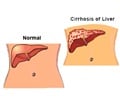Reducing weight by at least 5% with subsequent weight control and exercising regularly may be beneficial in treating nonalcoholic fatty liver disease.
Nonalcoholic fatty liver disease (NAFLD) is the most common cause of chronic liver disease in many countries. No proven treatment for patients with NAFLD is currently available. Understanding the specific effects of weight reduction and lifestyle modifications in patients with NAFLD is important for patient counseling as well as for designing future clinical trials.
To deal with these issues, researchers from Mayo Clinic College of Medicine, Rochester, USA, and Kanazawa University Hospital, Ishikawa, Japan sought to determine the association of changes in body weight and lifestyle behaviors (exercise, alcohol consumption, and smoking) with changes in serum alanine aminotransferase (ALT), and the association between maintaining lifestyle modifications and persistently normal ALT levels.In a study to be published in the next issue of the Journal of Hepatology, the researchers analyzed annual health checkup data from 1546 employees. Of 469 subjects with elevated ALT, they selected 348 male subjects by excluding those who had other causes of liver disease. They were followed for one year to assess the association of change in lifestyle with change in serum ALT. The 136 subjects who had ALT normalization were followed for two years to assess the association between lifestyle management and persistently normal ALT.
In the study, weight loss and regular exercise were significantly associated with improvement in serum ALT and increased the odds of ALT normalization, while starting smoking was significantly associated with deterioration in serum ALT. Subjects achieving ¡Ý5% weight reduction showed improvement in serum ALT. Maintaining reduced weight (<5% gain) was significantly associated with persistently normal ALT.
The results of the study indicate that reducing weight by at least 5% with subsequent weight control and exercising regularly may be beneficial in treating NAFLD. The information from this study is important for patient counseling and for the large population of individuals with hypertransaminasemia due to NAFLD.











